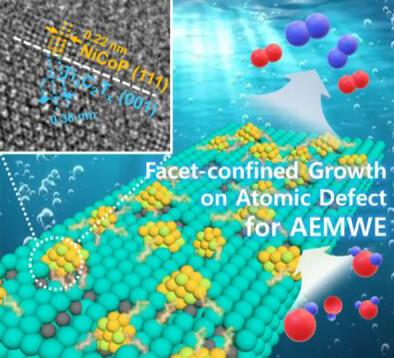Epitaxially Grown Bimetallic Phosphide With High Activity and Durability for Bifunctional Alkaline Anion Exchange Membrane Water Electrolysis
IF 19
1区 材料科学
Q1 CHEMISTRY, MULTIDISCIPLINARY
引用次数: 0
Abstract
Bimetallic phosphides stand promising candidates as bifunctional electrocatalysts for replacing precious noble metals on both cathode and anode in anion exchange membrane water electrolysis (AEMWE), however, the intrinsic electrochemical properties constrain their practical application. Herein, a novel hybridization approach is proposed for the facet-confined epitaxial growth of NiCoP derived on atomic defect-engineered Ti3C2Tx MXene (NiCoP@Ti3C2Tx). The efficient charge transfer across the heterointerface affects to optimizes the chemical state of the hybrid, simultaneously promoting both hydrogen evolution reaction (HER) and oxygen evolution reaction (OER) kinetics. Theoretical calculations reveal that such heterostructural engineering optimizes the adsorption energy of H/O-containing intermediates for overall water splitting. The outstanding bifunctionality of NiCoP@Ti3C2Tx is demonstrated by requiring low overpotentials of 54 and 247 mV to reach 10 mA cm−2 in HER and OER, respectively, and only 1.67 V to reach 100 mA cm−2 in overall water splitting. The AEMWE cell with symmetric NiCoP@Ti3C2Tx configuration exhibits excellent performance of 1.96 V at 1 A cm−2 with outstanding durability over 500 h at 0.5 A cm−2 at 60 °C, surpassing the commercial Pt/C||RuO2. Overall, this work shows the great potential of epitaxial growth of transition metal phosphides on defect-engineered 2D substrates to replace noble metal-based catalysts for practical AEMWE.

外延生长的高活性和耐用双金属磷化物用于双功能碱性阴离子交换膜电解
双金属磷化物作为双功能电催化剂在阴离子交换膜水电解(AEMWE)中替代阴极和阳极上的贵重贵金属具有良好的前景,但其固有的电化学性质限制了其实际应用。本文提出了一种新的杂化方法,用于原子缺陷工程Ti3C2Tx MXene衍生的NiCoP的面限外延生长(NiCoP@Ti3C2Tx)。异质界面上有效的电荷转移有助于优化杂化物的化学状态,同时促进析氢反应(HER)和析氧反应(OER)动力学。理论计算表明,这种异质结构工程优化了含H/ o中间体的吸附能,实现了水的整体裂解。NiCoP@Ti3C2Tx突出的双功能被证明,在HER和OER中分别需要低过电位54和247 mV达到10 mA cm - 2,在整体水分解中仅需要1.67 V达到100 mA cm - 2。具有NiCoP@Ti3C2Tx对称结构的AEMWE电池在1 A cm−2下具有1.96 V的优异性能,在0.5 A cm−2下在60°C下具有超过500小时的耐久性,超过了商用Pt/C||RuO2。总的来说,这项工作显示了过渡金属磷化物在缺陷工程2D衬底上外延生长的巨大潜力,可以取代贵金属基催化剂用于实际的AEMWE。
本文章由计算机程序翻译,如有差异,请以英文原文为准。
求助全文
约1分钟内获得全文
求助全文
来源期刊

Advanced Functional Materials
工程技术-材料科学:综合
CiteScore
29.50
自引率
4.20%
发文量
2086
审稿时长
2.1 months
期刊介绍:
Firmly established as a top-tier materials science journal, Advanced Functional Materials reports breakthrough research in all aspects of materials science, including nanotechnology, chemistry, physics, and biology every week.
Advanced Functional Materials is known for its rapid and fair peer review, quality content, and high impact, making it the first choice of the international materials science community.
 求助内容:
求助内容: 应助结果提醒方式:
应助结果提醒方式:


